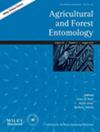Have native insect pests associated with a native crop in Maine declined over the past three to five decades? Les insectes nuisibles indigènes associés à une culture indigène dans le Maine ont-ils décliné les trois à cinq dernières décennies?
IF 1.8
3区 农林科学
Q2 ENTOMOLOGY
引用次数: 0
Abstract


在过去三五十年间,缅因州与本地作物相关的本地害虫是否减少了?
低丛蓝莓是美国缅因州、加拿大魁北克省和滨海省的重要浆果作物。缅因州其他重要的经济作物有马铃薯、奶制品和有机混合蔬菜。低丛蓝莓是由 1-4 个越橘品种组成的复合体,主要以艾顿越橘(Vaccinium angustifolium Aiton)为主。除一种害虫外,该作物系统中的所有害虫种类都原产于北美管理该作物的地区。昆虫的减少已被证明是一个最新的全球现象,但却很少在农业生态系统中进行研究。昆虫物种丰度的长期数据集是研究昆虫种群趋势的有力工具。为了确定缅因州低丛蓝莓中的本地害虫在过去几十年中是否减少,我们调查了三种本地物种。所有调查都是在商业蓝莓田中进行的;不过,所有样本地点都没有喷洒杀虫剂。昆虫害虫取样包括两次针对蓝莓蛆蝇(Rhagoletis mendax Curran)幼虫阶段的调查(1961-2014 年和 1998-2017 年)、一次针对蓝莓食心虫(Itame argillacearia (Packard))幼虫阶段的调查(1981-2016 年)和一次针对蓝莓跳甲(Altica sylvia Malloch)幼虫阶段的调查(1983-2019 年)。根据我们对长期种群水平数据集的分析,我们没有发现任何证据表明与北美原生作物低丛蓝莓密切相关的这一原生蓝莓虫害复合体出现了虫害衰退,尽管最近有文献记载低丛蓝莓产区发生了快速的气候变化。
本文章由计算机程序翻译,如有差异,请以英文原文为准。
求助全文
约1分钟内获得全文
求助全文
来源期刊

Agricultural and Forest Entomology
农林科学-昆虫学
CiteScore
3.60
自引率
6.20%
发文量
66
审稿时长
>24 weeks
期刊介绍:
Agricultural and Forest Entomology provides a multi-disciplinary and international forum in which researchers can present their work on all aspects of agricultural and forest entomology to other researchers, policy makers and professionals.
The Journal welcomes primary research papers, reviews and short communications on entomological research relevant to the control of insect and other arthropod pests. We invite high quality original research papers on the biology, population dynamics, impact and management of pests of the full range of forest, agricultural and horticultural crops.
 求助内容:
求助内容: 应助结果提醒方式:
应助结果提醒方式:


